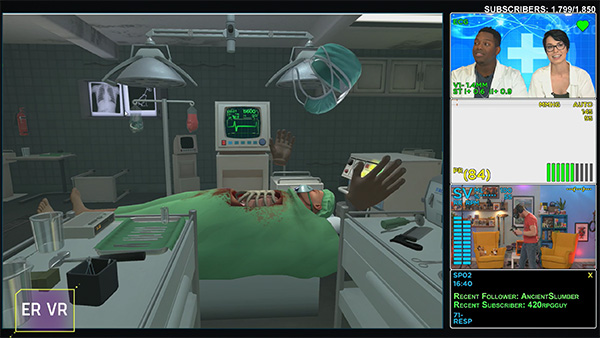With VREAL, audiences can come together in a virtual space to watch content created in VR games. Unlike traditional streams, content creators can place virtual cameras inside a game to broadcast to 2D platforms such as Twitch, so viewers aren’t stuck seeing everything from the player’s point-of-view. Meanwhile, those with VR headsets can meet-up in a virtual hub space, interact with each other, jump into game broadcasts as a group, then move around the game space and interact with the streamer in fun ways.
The best demonstration of VREAL technology came with the launch of the Twitch show, ER VR, created by Hyper RPG and sponsored by Akamai and Alienware computers. In the live show, guests play the comedic game, Surgeon Simulator: Experience Reality as other fake doctors look on, offer commentary, and judge their performance.
VREAL CEO, Todd Hooper, and the company’s VP of marketing, Bryan Chu both sat down to chat with [a]listdaily. The two talked about the debut of ER VR and how the VREAL platform could help virtual reality further grow as an entertainment medium.

How would you say VREAL will help VR grow?
[Hooper]: If you look at the two big trends over the past five-to-ten years, we think that one of them is that VR is the future of gaming. Gamers have been waiting for this technology since reading science fiction. The other big trend is that games themselves have become media. Games aren’t just something that you just play, they’re something that you watch. Now, there are more people watching games at any time than playing them. The way people watch games today is on a flat screen using video, whether it’s live on demand. We think that VREAL is the way games will be viewed in VR in the future and sharing that content. But it’s not using [2D] video, we’re re-rendering that world around you. It’s fully immersive VR tech.
Can both premium VR headset and mobile users come together using VREAL?
[Hooper]: The platform is designed to scale to many people watching content. Certainly, there is some content that is better suited for the desktop for high-end, and some content better suited for the low-end. What we’re seeing today is that most people who stream games today are doing it from PCs, not mobile. Generally, if you look on Twitch or YouTube, most of those people are creating content on PCs, not mobile phones or consoles, so that’s why we’re starting there.
How do you create the excitement of VR on a 2D platform such as Twitch?
[Hooper]: In the past, you’ve been limited to a single viewpoint. So, when I’m playing Surgeon Simulator, you’re seeing my viewpoint, and every time I move my head, you see things move around. That’s nauseating at best and it’s infuriating to watch that. VREAL lets you pull that viewpoint away from the player and put the cameras around the room. So, when you watch ER VR, you get all sorts of views–almost like there was a film crew in the operating theatre. You get the view above the patient, you can see the player, and you’re not locked into the player’s point-of-view. Generally, when you go to a movie, you want to see the actor, you don’t want to see from the actor’s eyes.
If you are filming a movie, you wouldn’t go in with just a single camera held to your head. You’d set up a bunch of different cameras and angles. We’re effectively enabling streamers to do that. As long as you give the streamers the tools to create something great, they’ll amaze you with their creativity.
[Chu]: If you’re watching something through a screen, that’s your entire world. It doesn’t matter if what’s on the other side of the camera is Times Square, Seattle, San Francisco or a VR space. The idea of conveying VR to you, as a viewer watching in 2D, is conveying that the space is real. It isn’t about the headset feed. Strapping a GoPro to my head doesn’t give you a sense of immersion and space. The way for me to communicate space to you already exists. It is to treat it like the real world and position multiple cameras, with multiple views and dramatic angles. That’s the way you’re ready to consume it. Up until now, we haven’t been able to do that in virtual spaces. By being able to inhabit the space by putting in cameras, VREAL is able to transform virtual worlds into “real” worlds.
Will the conversations in the hub space be audible and in real-time?
[Hooper]: We’re still evolving how that’s going to be for general public experience. The vision for right now is that it’s where you go to meet your friends. You’re not going to drop 1,000 people in there. That’s the place you go when I send you a link to watch a stream. We effectively come into this place as friends and then go into the game together.

What are some of the social features?
[Hooper]: When you’re in VR, you have head tracking and hand to tracking. I do look you in the eyes, wave at you, and interact physically. We have voice so you can speak with people and emotes to express your emotions. You can also move around the space and stand in different groups. Even though you might be sitting at your desk, you feel like you move around [in the virtual space] to different groups for a bit of privacy. We also let you take video and photos—everyone wants their photo taken in VR. Most things lend themselves to social sharing on Twitter or other platforms.
[Chu]: The social features continue to evolve as we move forward. That platform is it rolling out monolithically. We just launched the recording client that we’ve been working on with key partners like Hyper RPG. They give us valuable feedback on what they want to capture. That’s our approach: we work with customers to help them help us define the experiences that they find most valuable.
How will VR interaction work when there are a lot of viewers?
[Chu]: Imagine a stadium with infinite box seats. Each box seat holds a quantity of people—say, somewhere between one and ten. That’s our group of friends, and that’s who you going to interact with. The developer also controls that viewing experience. For example, in Surgeon Simulator, the space is a very tight. A box with more than four people will impact the viewing experience. But maybe a game with wide open vistas will have eight people. So, imagine being able to walk into a concert and turning it into a small park experience.
We can also do a “main stage” event that’s viewable to everybody. A host will put on a show and there will be people watching in native VR and the host can interact with them there. Meanwhile, we have a camera crew broadcasting to Twitch and YouTube. So, through one experience, we’re able to provide something for people in VR and 2D audiences with highly interactive social experiences.
[Hooper]: You feel like you’re having a personal experience just with that streamer, but in fact there are multiple instances with groups.
How would you describe ER VR?
[Chu]: ER VR is the first show using the VREAL platform, coming from Hyper RPG using Bossa Studios’ Surgeon Simulator. It’s the first show filmed in VR and broadcast to Twitch as a 2D show, turning a VR space into a sound stage.
What inspired the creation of the show?
[Hooper]: Zack [Eubank] is the president of Hyper RPG. We just brought him in and gave him a demo, showing him some of the stuff we were working on. I think that planted the seed. He came back and pitched us on an idea for a weekly show. He would bring in a guest doctor every week and have pretend doctors judge them. I think it’s really fun and it’s effectively the first time the VREAL tech is being shown publicly. We’re very happy with it.
[Chu]: It’s a great way to show how, once you are able to get inside the game, you can create a huge variety of content. Normally, when you’re streaming a game, you’re basically held prisoner by the player camera. There’s only so much you can do when creating interesting programming around that. But because VREAL is integrated and has cameras inside the game, they are able to put on a show that you wouldn’t otherwise be able to do. They can basically film a comedy hospital drama inside an operating theater. Hyper RPG came up with this concept, but others might do something different.
[Hooper]: That same concept can be used for show that’s humorous, competitive or whatever you feel like doing. Again, we’re creating the tools and the platform for those creative people to do what they do best.
Will you still consider it great success for VR if more people end up preferring to watch content through Twitch than from a headset?
[Hooper]: Definitely. Twitch is a great partner, and we’ve worked closely with them on ER VR. The fact is, it evangelize VR and gives people a way to experience it before they get their own headset. Today, 99 percent of that audience is on Twitch and YouTube, not a VR headset. We see that as the onramp to the future, where more gamers VR.
[Chu]: I think we’re witnessing the birth of a new media. I always draw the analogy of the radio world and the birth of television. Those first television shows were basically a radio shows but with cameras. People didn’t really understand how to use it or what they could do with it. What you’ll see is that, as people learn the medium and what to do, not only will the content creators get more sophisticated but the audience will get more sophisticated too. We as audiences evolve along with the media. It becomes a journey that everyone goes on together.
The thing about the VREAL approach is that we partner with developers and content creators to serve audiences to consume content that they want in the best way that’s possible. Ultimately, that means we raise the bar. The aspiration has always been to create virtual worlds that are more compelling than the real world with games. Now we are able to do that.
What are your thoughts on how VR technology has grown so far?
[Hooper]: We always thought it would be a long-term transition. It wasn’t going to be last year or this year that everyone suddenly has a VR headset. We think it will be three to five years before it becomes mainstream. I think the first year went great—hundreds of thousands of people bought headsets. So, clearly gamers are interested. There’s more work to be done on hardware, and more work to be done on content, but I think we’re off to a very good start. Anyone who thought there would be tens of millions of headsets sold in the first year were probably being a little overoptimistic.
We’ve always been realistic and we’re taking our time. But there’s more hardware coming to market. The reality is that you’ve got Facebook, Google, Valve, HTC, Microsoft and possibly Apple all lining up behind VR. So, it’s a thing. It’s here, and it may take a little while to make a headset that fits every possible person, but we’ll get there.

